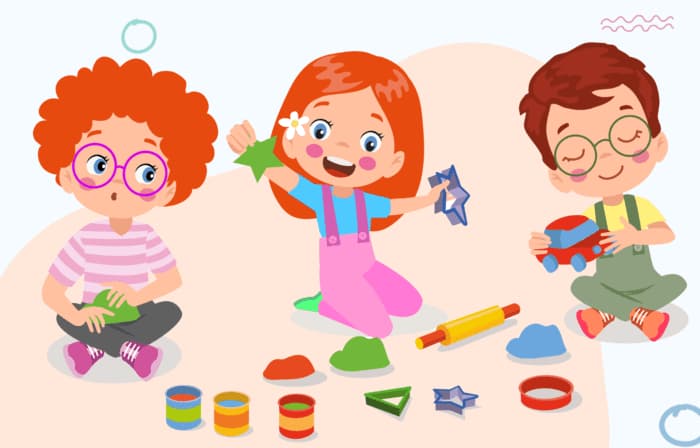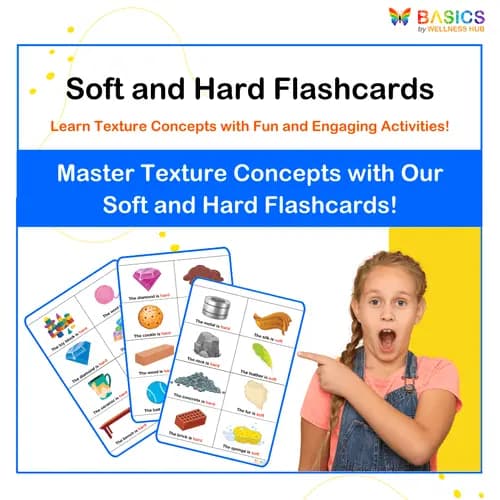Sensory Activities
Enhance your child’s sensory development with our Sensory Activities Home Therapy Resources. These tools engage multiple senses through structured play, supporting sensory processing, coordination, and attention in a fun, exploratory way.

Explore the Best Sensory Activities Resources for Kids

Match the Color – Identify and Match Objects with Their Colors
₹ 80.00
₹ 160.00
50% off
4.9 (52 ratings)

Soft and Hard Flashcards: Learn Texture Concepts with Everyday Objects
₹ 80.00
₹ 160.00
50% off
4.6 (58 ratings)

Hot and Cold Flashcards: Learn Temperature Concepts with Objects
₹ 80.00
₹ 160.00
50% off
4.8 (44 ratings)
Real Parent Success Stories – How Sensory Activities Resources Help Kids Thrive
Our resources have positively impacted families and therapists, helping children make meaningful progress in speech and language development. Here’s what some of our users have shared:
The tactile cards have been amazing. My son used to be sensitive to different textures, but now he enjoys exploring new things. He’s much more comfortable with touch.
Jane, Parent
These testimonials reflect how our resources make speech and language learning accessible and effective, empowering children and giving parents the confidence to support their growth.
Detailed Description
Introduction to Sensory Activities for Early Development
Sensory activities are essential for children’s early development, helping them explore the world through touch, sight, sound, smell, and movement. These experiences stimulate brain growth, enhance cognitive processing, and support motor skills, laying the foundation for learning and adaptability. Our sensory activities provide parents, educators, and therapists with structured, engaging resources to encourage sensory exploration and integration, making learning hands-on, fun, and beneficial for young minds.
How Our Resources Aid in Sensory Integration and Development
Our sensory resources support sensory integration by providing children with diverse sensory experiences. Tactile activities, such as textured flashcards, enhance touch awareness, while auditory resources introduce sound recognition and auditory processing. Visual exercises improve visual tracking and focus, and movement-based activities support proprioception and balance. These resources help children make sense of sensory inputs, promoting skills like focus, coordination, and spatial awareness, all of which are vital for physical and cognitive development.
Types of Sensory Activity Resources We Offer
Tactile Exploration Cards and Materials: Our tactile resources include a variety of textured flashcards and objects designed to engage children’s sense of touch. By exploring different textures, such as soft, rough, smooth, and bumpy, children develop fine motor skills, improve sensory processing, and learn to categorize tactile sensations.
Auditory Activities for Sound Recognition: Auditory activities introduce children to sounds through sound-matching exercises and noise-making objects. These activities enhance auditory processing and recognition, helping children differentiate between sounds, improve attention, and develop listening skills.
Visual Tracking and Focus Exercises: Our visual activities use colors, shapes, and movement to engage children’s visual skills. These exercises promote focus, tracking, and attention, which are essential for reading and other visual tasks, strengthening children’s ability to follow objects and stay visually engaged.
Proprioception and Balance Activities: Movement-based activities encourage children to explore their body’s position in space, aiding proprioceptive development. Through exercises that involve balance and coordination, children improve physical awareness and control, which supports tasks like walking, running, and handling objects with ease.
Who Can Use These Resources?
Our sensory activities resources are versatile and beneficial for a range of users:
Parents: Use these activities at home to engage children in sensory play, promoting sensory integration and motor skills in a comfortable setting.
Teachers: Integrate sensory activities into the classroom to support children’s focus, sensory processing, and physical coordination.
Therapists: Apply these tools in therapy sessions to help children with sensory processing needs, providing targeted, sensory-rich experiences that aid regulation.
These resources are designed to be easy to use and adaptable, making it simple for anyone working with children to support sensory development effectively and engagingly.
Benefits of Sensory Development Activities at Home
Practicing sensory activities at home offers children a safe and familiar environment to explore and develop sensory skills. These resources make it easy for parents to introduce children to textures, sounds, and visual stimuli, which aid sensory integration and awareness. For children with sensory processing challenges, structured activities provide repeated, focused exposure that promotes sensory tolerance and self-regulation. By incorporating sensory play into daily routines, parents can foster a well-rounded sensory foundation that supports cognitive, physical, and emotional growth.
Tips for Using Sensory Activities Effectively
Using sensory activities effectively can help children build strong sensory integration and processing skills. Here are some practical tips:
Start with Familiar Sensory Inputs: Begin with familiar textures, sounds, or visuals that your child is comfortable with before introducing new or challenging sensory inputs. This approach builds confidence and reduces overwhelm.
Incorporate Sensory Play into Daily Routines: Sensory activities can be part of everyday routines, such as using textured toys during playtime or playing soft music during quiet time. Regular exposure helps reinforce sensory development.
Observe and Adapt: Pay attention to how your child responds to different sensory inputs. Adjust the activity based on their comfort level to make sure it’s a positive experience.
Use Repetition and Consistency: Consistent practice with sensory activities helps reinforce sensory pathways in the brain. Try to introduce a variety of sensory experiences regularly to build tolerance and adaptability.
Make it Fun and Interactive: Sensory activities should be enjoyable. Use items your child finds interesting and fun, such as sensory bins, sound-making toys, or colorful objects, to keep them engaged and curious.
Real-Life Examples of Sensory Development with Our Resources
Our sensory activities resources provide practical ways for children to engage their senses, build sensory tolerance, and explore the world around them. Here are some examples:
Developing Touch Awareness with Tactile Flashcards: A parent might use Tactile Flashcards to introduce their child to different textures like rough, soft, and smooth. By exploring these textures, the child becomes more comfortable with new tactile sensations, which is especially helpful for children who may have tactile sensitivities.
Enhancing Auditory Skills with Sound Matching: A teacher might use Auditory Sound Cards to introduce different sounds, helping students differentiate between them. This activity supports auditory processing and listening skills, building a foundation for focus and attention in a classroom setting.
Improving Visual Tracking with Shape and Color Exercises: A therapist might use Visual Tracking Cards to help a child follow and focus on moving objects, strengthening eye muscles and improving attention. These exercises are beneficial for reading readiness and visual coordination.
Building Physical Awareness with Balance Activities: A parent could engage their child in Balance Activities that involve standing on one foot or walking along a line. These activities help children improve proprioception, coordination, and balance, essential skills for daily tasks.
These examples highlight how our resources support various aspects of sensory development, helping children build confidence, adaptability, and sensory awareness.
FAQs
Q1: How do I start using these sensory resources with my child?
A1: Begin with sensory experiences that your child already enjoys, such as textures or sounds they are familiar with. Gradually introduce new sensory activities over time as they build confidence.
Q2: Which resources are best for tactile sensitivity?
A2: Our Tactile Exploration Cards are ideal for introducing different textures in a gentle, structured way. They help children get used to a variety of tactile sensations.
Q3: How often should I use these activities?
A3: Consistent, short sessions work best. Aim for sensory play daily or a few times a week, incorporating it into regular routines to make it enjoyable and less overwhelming.
Q4: Are these resources suitable for children with sensory processing challenges?
A4: Yes, our resources are designed to support children with a range of sensory needs, providing gentle, engaging activities that help with sensory integration and regulation.
Related Topics and Further Learning for Parents
For parents interested in further supporting their child’s sensory development, the BASICS app offers additional resources and courses focused on sensory processing and integration:
Building Tactile Tolerance and Exploration: A course that introduces activities and techniques to help children become comfortable with different textures and touch experiences.
Auditory Processing and Sound Awareness: Resources that focus on helping children improve auditory recognition and processing through sound-based activities.
Visual Tracking and Focus Development: Tools to enhance visual skills, promoting eye-tracking and focus essential for reading and other visual tasks.
Proprioception and Motor Skills: A course that supports physical coordination and awareness, helping children develop balance and control through movement-based exercises.
These resources provide parents with a comprehensive approach to sensory development, helping children build sensory integration skills essential for everyday life.